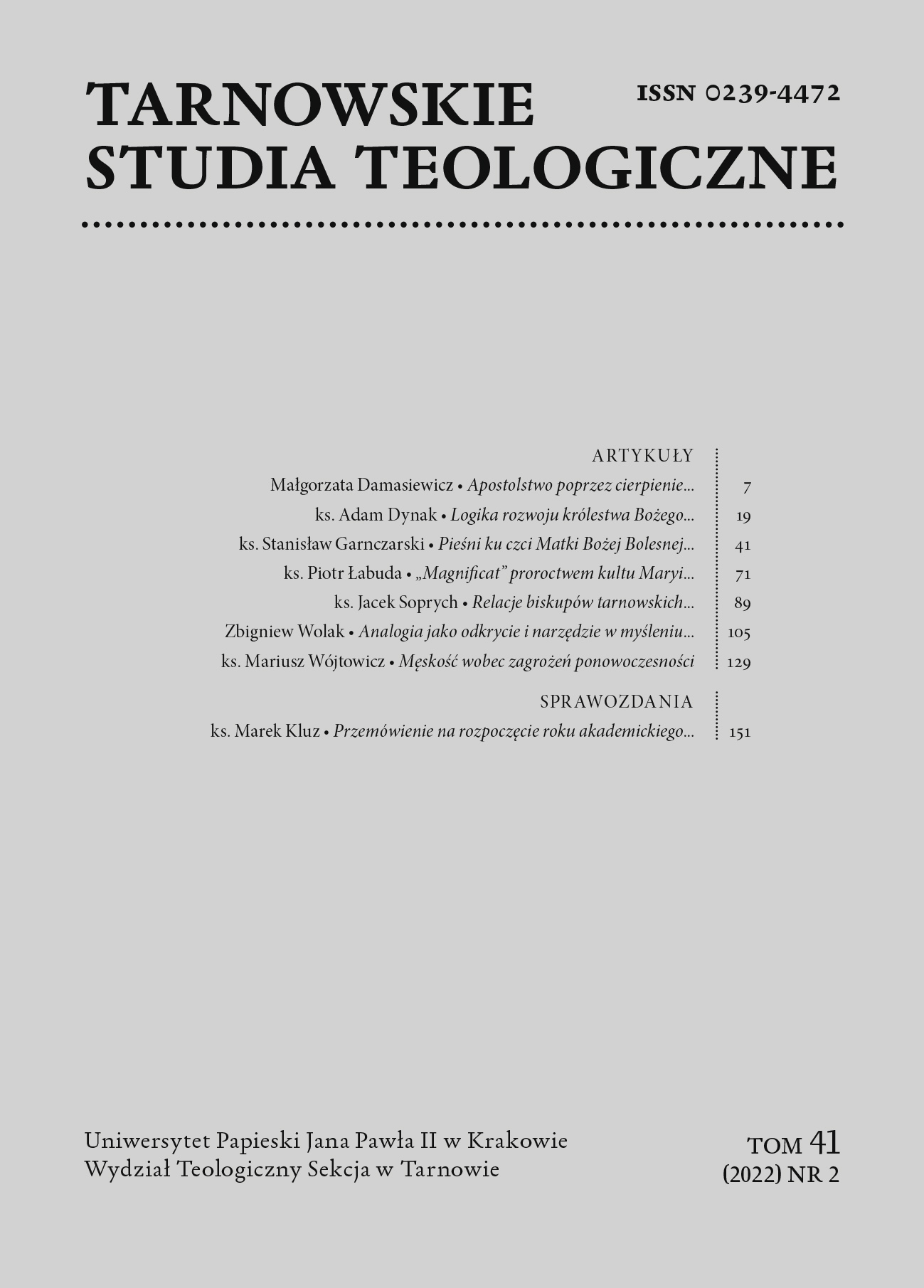„Magnificat” proroctwem kultu Maryi. „Oto bowiem błogosławić mnie będą odtąd wszystkie pokolenia” (Łk 1, 48)
DOI:
https://doi.org/10.15633/tst.41204Słowa kluczowe:
Maryja, proroctwo, Magnificat, błogosławieństwo, kultAbstrakt
Pośród licznych tekstów nowotestamentalnych za szczególny można uznać przekazany przez św. Łukasza hymn Magnificat. Przybywająca do swojej krewnej Maryja, odpowiadając na pozdrowienie Elżbiety, wielbi Boga za wielkie rzeczy, które On czynił i wciąż czyni. Z pewnością dostępny dziś kantyk nie jest zapisem stenograficznym słów Maryi. Trudno jednak przyznać, że jest on dziełem autora trzeciej ewangelii, a Maryja nie miała nic wspólnego z tym przekazem. Wielbiąc Boga, Maryja zapowiada swój przyszły kult. Ze względu na to ojcowie Kościoła nazwali ją prorokinią. Maryja miała pełną świadomość, że otrzymała niezwykły Boży dar – Boże wybranie: „Wielkie rzeczy uczynił mi Wszechmocny”. Konsekwencją tego niezwykłego Bożego daru są także jej prorockie słowa, że wszystkie pokolenia będą ją wielbiły.
Bibliografia
Abramek R. J., Implikacje „Magnificat” (Łk 1, 46–55) dla teologii sanktuarium maryjnego, „Studia Claromontana” 4 (1983), s. 5–31.
Bednarz M., Ewangelia św. Łukasza, t. 1: 1, 1–8, 56, Tarnów 2000.
Bednarz M., Ewangelia wg św. Łukasza (Łk 1, 1–12, 59), Tarnów 2009.
Beinert W., Heute von Maria reden? Kleine Einführung in die Mariologie, Freiburg 1973.
Budzik S., Maryja w tajemnicy Chrystusa i Kościoła, Tarnów 1997.
Dąbek T. M., „Odtąd bowiem błogosławić mnie będą wszystkie pokolenia” (Łk 1, 48). Czy Maryja miała świadomość Jej przyszłego kultu?, „Salvatoris Mater” 4 (2002) nr 4, s. 34–43.
Ernst J., Das Evangelium nach Lukas, Regensburg 1977.
Fitzmyer J. A., The Gospel According to Luke (I–IX). Introduction, Translation and Notes, New York 1981.
Gozzini V. O., Zrodzony z niewiasty, „Salvatoris Mater” 9 (2007) nr 1–2, s. 87–97.
Grzymska U., Elementy paschalnej radości w „Magnificat”. Studium egzegetyczno-teologiczne, Kraków 1996.
Haręzga S., Bóg Maryi w świetle hymnu „Magnificat” (Łk 1, 46b–55), „Salvatoris Mater” 1 (1999) nr 2, s. 132–146.
Kudasiewicz J., Matka Odkupiciela, Kielce 1991.
Langkammer H., Maryja w Nowym Testamencie, Gorzów Wielkopolski 1991.
Laurentin R., Matka Pana. Krótki traktat teologii maryjnej, Warszawa 1989.
Mickiewicz F., Ewangelia według św. Łukasza. Wstęp. Przekład z oryginału. Komentarz, cz. 1: Rozdziały 1–11, Częstochowa 2011.
Mikołajczak M., Pozycja społeczna Maryi (Łk 1, 5–2, 52), „Salvatoris Mater” 1 (1999) nr 3, s. 216–230.
Nolland J., Luke 1, 1–9, 20, Dallas 1989.
Paciorek A., Ewangelia według św. Mateusza. Wstęp. Przekład z oryginału.
Komentarz, cz. 1: Rozdziały 1–13, Częstochowa 2004.
Popowski R., Wielki słownik grecko-polski Nowego Testamentu, Warszawa 2006, s. 380–381.
Schürmann H., Das Lukasevangelium 1, Freiburg–Basel–Wien 1969.
Stabryła W. M., „Raduję się w Bogu”. Hymn Anny (1 Sm 2, 1b–10) hymnem Maryi (Łk 1, 46b–55), „Salvatoris Mater” 8 (2006) nr 3–4, s. 38–39.
Stefaniak L., Interpretacja 12 rozdziału Apokalipsy św. Jana w świetle historii egzegezy, Poznań 1957.
Karczewski M., Między historią idei a oryginalnością Ap 12 — w poszukiwaniu metody interpretacji, „Studia Elbląskie” 2 (2000), s. 219–236.
Tronina A., „Magnificat” — portret duszy Maryi, „Salvatoris Mater” 8 (2006) nr 3–4, s. 22–37.
Valentini A., Pierwsze zapowiedzi oddawania czci Matce Pana (Łk 1, 39–45), „Salvatoris Mater” 4 (2002) nr 4, s. 11–33.
Walton J. H., Matthews V. H., Chavalas M. W., Komentarz historyczno-kulturowy do Biblii hebrajskiej, Warszawa 2005.
Wendlik K., Maryja jako Matka Miłosierdzia w aspekcie jej „ipsissima verba et facta” oraz źródeł teologicznych z I tysiąclecia, „Łódzkie Studia Teologiczne” 24 (2015) nr 4, s. 99–110.
Pobrania
Opublikowane
Numer
Dział
Licencja
Prawa autorskie (c) 2022 Piotr Łabuda

Utwór dostępny jest na licencji Creative Commons Uznanie autorstwa 4.0 Międzynarodowe.
Autorzy publikujący w czasopiśmie udzielają jego wydawcy zgody o następującej treści:
- Autor zachowuje autorskie prawa majątkowe do utworu, a jednocześnie udziela wydawcy czasopisma zgody na jego pierwszą publikację w wersji drukowanej i wersji online na licencji Creative Commons Uznanie autorstwa 4.0 Międzynarodowe oraz zgody na wykonywanie opracowań, w tym przekładów.
- Autor ma możliwość udzielania zgody niewyłącznej na opublikowanie utworu w wersji, która ukazała się w czasopiśmie (np. zamieszczenia go w repozytorium instytucjonalnym lub opublikowania w książce), wraz z informacją o jego pierwszej publikacji w czasopiśmie.
- Autor może umieścić swój utwór online (np. w repozytorium instytucjonalnym lub na swojej stronie internetowej) jeszcze przed zgłoszeniem utworu do czasopisma.

